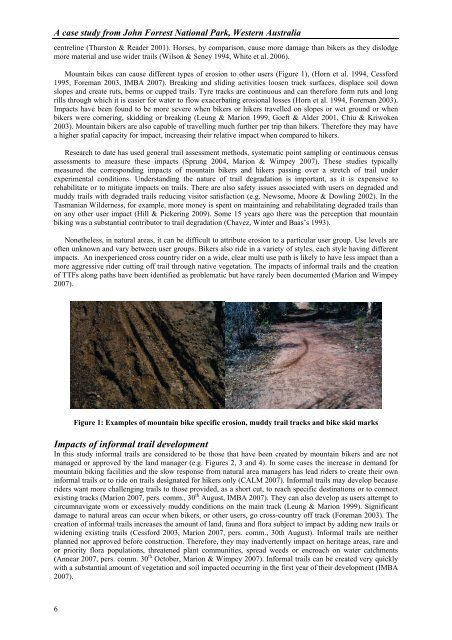Mountain bike activity in natural areas - Murdoch Research ...
Mountain bike activity in natural areas - Murdoch Research ...
Mountain bike activity in natural areas - Murdoch Research ...
You also want an ePaper? Increase the reach of your titles
YUMPU automatically turns print PDFs into web optimized ePapers that Google loves.
A case study from John Forrest National Park, Western Australia<br />
centrel<strong>in</strong>e (Thurston & Reader 2001). Horses, by comparison, cause more damage than <strong>bike</strong>rs as they dislodge<br />
more material and use wider trails (Wilson & Seney 1994, White et al. 2006).<br />
<strong>Mounta<strong>in</strong></strong> <strong>bike</strong>s can cause different types of erosion to other users (Figure 1), (Horn et al. 1994, Cessford<br />
1995, Foreman 2003, IMBA 2007). Break<strong>in</strong>g and slid<strong>in</strong>g activities loosen track surfaces, displace soil down<br />
slopes and create ruts, berms or cupped trails. Tyre tracks are cont<strong>in</strong>uous and can therefore form ruts and long<br />
rills through which it is easier for water to flow exacerbat<strong>in</strong>g erosional losses (Horn et al. 1994, Foreman 2003).<br />
Impacts have been found to be more severe when <strong>bike</strong>rs or hikers travelled on slopes or wet ground or when<br />
<strong>bike</strong>rs were corner<strong>in</strong>g, skidd<strong>in</strong>g or break<strong>in</strong>g (Leung & Marion 1999, Goeft & Alder 2001, Chiu & Kriwoken<br />
2003). <strong>Mounta<strong>in</strong></strong> <strong>bike</strong>rs are also capable of travell<strong>in</strong>g much further per trip than hikers. Therefore they may have<br />
a higher spatial capacity for impact, <strong>in</strong>creas<strong>in</strong>g their relative impact when compared to hikers.<br />
<strong>Research</strong> to date has used general trail assessment methods, systematic po<strong>in</strong>t sampl<strong>in</strong>g or cont<strong>in</strong>uous census<br />
assessments to measure these impacts (Sprung 2004, Marion & Wimpey 2007). These studies typically<br />
measured the correspond<strong>in</strong>g impacts of mounta<strong>in</strong> <strong>bike</strong>rs and hikers pass<strong>in</strong>g over a stretch of trail under<br />
experimental conditions. Understand<strong>in</strong>g the nature of trail degradation is important, as it is expensive to<br />
rehabilitate or to mitigate impacts on trails. There are also safety issues associated with users on degraded and<br />
muddy trails with degraded trails reduc<strong>in</strong>g visitor satisfaction (e.g. Newsome, Moore & Dowl<strong>in</strong>g 2002). In the<br />
Tasmanian Wilderness, for example, more money is spent on ma<strong>in</strong>ta<strong>in</strong><strong>in</strong>g and rehabilitat<strong>in</strong>g degraded trails than<br />
on any other user impact (Hill & Picker<strong>in</strong>g 2009). Some 15 years ago there was the perception that mounta<strong>in</strong><br />
bik<strong>in</strong>g was a substantial contributor to trail degradation (Chavez, W<strong>in</strong>ter and Baas’s 1993).<br />
Nonetheless, <strong>in</strong> <strong>natural</strong> <strong>areas</strong>, it can be difficult to attribute erosion to a particular user group. Use levels are<br />
often unknown and vary between user groups. Bikers also ride <strong>in</strong> a variety of styles, each style hav<strong>in</strong>g different<br />
impacts. An <strong>in</strong>experienced cross country rider on a wide, clear multi use path is likely to have less impact than a<br />
more aggressive rider cutt<strong>in</strong>g off trail through native vegetation. The impacts of <strong>in</strong>formal trails and the creation<br />
of TTFs along paths have been identified as problematic but have rarely been documented (Marion and Wimpey<br />
2007).<br />
6<br />
Figure 1: Examples of mounta<strong>in</strong> <strong>bike</strong> specific erosion, muddy trail tracks and <strong>bike</strong> skid marks<br />
Impacts of <strong>in</strong>formal trail development<br />
In this study <strong>in</strong>formal trails are considered to be those that have been created by mounta<strong>in</strong> <strong>bike</strong>rs and are not<br />
managed or approved by the land manager (e.g. Figures 2, 3 and 4). In some cases the <strong>in</strong>crease <strong>in</strong> demand for<br />
mounta<strong>in</strong> bik<strong>in</strong>g facilities and the slow response from <strong>natural</strong> area managers has lead riders to create their own<br />
<strong>in</strong>formal trails or to ride on trails designated for hikers only (CALM 2007). Informal trails may develop because<br />
riders want more challeng<strong>in</strong>g trails to those provided, as a short cut, to reach specific dest<strong>in</strong>ations or to connect<br />
exist<strong>in</strong>g tracks (Marion 2007, pers. comm., 30 th August, IMBA 2007). They can also develop as users attempt to<br />
circumnavigate worn or excessively muddy conditions on the ma<strong>in</strong> track (Leung & Marion 1999). Significant<br />
damage to <strong>natural</strong> <strong>areas</strong> can occur when <strong>bike</strong>rs, or other users, go cross-country off track (Foreman 2003). The<br />
creation of <strong>in</strong>formal trails <strong>in</strong>creases the amount of land, fauna and flora subject to impact by add<strong>in</strong>g new trails or<br />
widen<strong>in</strong>g exist<strong>in</strong>g trails (Cessford 2003, Marion 2007, pers. comm., 30th August). Informal trails are neither<br />
planned nor approved before construction. Therefore, they may <strong>in</strong>advertently impact on heritage <strong>areas</strong>, rare and<br />
or priority flora populations, threatened plant communities, spread weeds or encroach on water catchments<br />
(Annear 2007, pers. comm. 30 th October, Marion & Wimpey 2007). Informal trails can be created very quickly<br />
with a substantial amount of vegetation and soil impacted occurr<strong>in</strong>g <strong>in</strong> the first year of their development (IMBA<br />
2007).

















